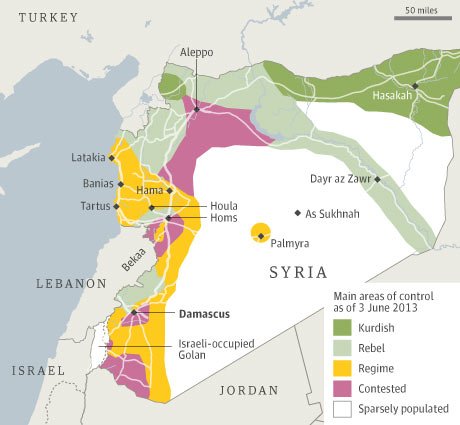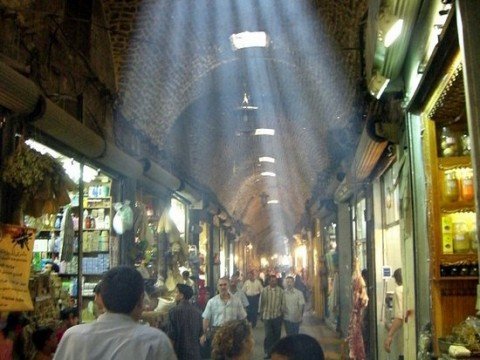by Seth Kaplan | Aug 27, 2013 | Conflict and security, Middle East and North Africa
 As the war in Syria drags on, it is becoming ever more vicious. Militias kill hundreds of civilians, ethnic cleansing large swaths of the country in the process. Rebel groups fight among themselves for territory and even assassinate each other’s leaders. Prisoners are regularly tortured. Millions have fled their homes in fear. 100,000 are dead. Extremists now hold the upper hand on both sides. In the latest outrage, the Assad regime has apparently used chemical weapons, gassing hundreds to death.
As the war in Syria drags on, it is becoming ever more vicious. Militias kill hundreds of civilians, ethnic cleansing large swaths of the country in the process. Rebel groups fight among themselves for territory and even assassinate each other’s leaders. Prisoners are regularly tortured. Millions have fled their homes in fear. 100,000 are dead. Extremists now hold the upper hand on both sides. In the latest outrage, the Assad regime has apparently used chemical weapons, gassing hundreds to death.
Where will all this misery lead? What does the future of Syria hold?
As I warned in 2011, Syria is a complex mosaic of different ethnic, religious, and ideological groups, a tinderbox that was destined to explode if the fragile peace that the Assad regime enforced was disturbed. Now that the country has imploded, there is no easy way out. (more…)
by Kirsty McNeill | Jul 18, 2013 | Conflict and security, Cooperation and coherence, Global system
The painful choices facing left interventionists, part of our series on #progressivedilemmas.
by Richard Gowan | Mar 27, 2013 | Conflict and security, Global Dashboard, Middle East and North Africa

It’s six months since Kofi Annan stepped down as UN-Arab League envoy for Syria. Does he have second thoughts about his efforts to mediate an end to the civil war last year? He said something odd this week:
“I don’t see a military intervention in Syria. We left it too late. I’m not sure it would not do more harm,” he told the Graduate Institute in Geneva on Tuesday night. “Further militarisation of the conflict, I’m not sure that is the way to help the Syrian people. They are waiting for the killing to stop. You find some people far away from Syria are the ones very keen for putting in weapons.”
Annan went on to say that he still thinks a political solution is the only viable option, although he’s pessimistic about the chances of achieving this. Still, his “we left it too late” line is striking. Does he think that a military intervention might have been feasible a year ago, when he was trying to secure a ceasefire?
Earlier this month, I wrote a commentary for Stability – an up-and-coming online journal devoted to conflict issues – about Annan’s early days as Syria envoy in February and March 2012. I argue that the chances of a military intervention were always low, but there was “prevailing uncertainty about how the intentions of major powers towards Syria might evolve as the crisis continued.”
Russia appeared genuinely convinced that the West might use force. And while the Assad government responded to the splits in the Security Council by escalating military operations, it could not be certain that its Arab and Western opponents might not take a more aggressive line. This doubt was a potential point of leverage for Annan. Should he take advantage of the uncertainties over external powers’ intentions or try to clarify them?
How did the former UN Secretary-General handle this dilemma?
After his appointment Annan pulled together a team of veteran UN officials and set up office in Geneva. While his team was highly loyal to him, divisions emerged over what strategy he should adopt. A relatively hawkish faction believed that Annan could use the swirling uncertainty to persuade Assad that his position was unsustainable. A more dovish group felt that it was necessary to reassure both Assad and the Russians that regime change was not imminent, creating a framework for talks. The doves were convinced that the chances of an outside intervention were still infinitesimally low and that it was essential to disabuse those opposition forces hoping for a repeat of the Libyan episode. Meanwhile UN Secretary-General Ban Ki-moon, who has mixed relations with Annan, was pressing hard for an early ceasefire.
Annan visited Damascus on 10 March 2012 and held difficult talks with Assad, who declared he would not talk to “terrorists”. Although declaring himself disappointed by this encounter, Annan opted to follow the dovish route. His six-point plan was an effort to create a climate of confidence both outside and inside Syria. By tabling proposals that all the members of the Security Council could approve, he eased tensions between Russia and the West. By getting these powers to sign on to a deliberately non-threatening text, he reassured Assad that the chances of an intervention were low.
So if “we left it too late” to intervene, Annan was partially responsible for the delay. You can read the rest of the Stability article – including some thoughts on what Annan could have done differently – here.
by Seth Kaplan | Feb 22, 2012 | Middle East and North Africa
Aleppo’s famed souk is arguably the most vibrant and interesting in the whole Middle East.

What differentiates it from other great markets in the region (such as my other favorites in Sana’a in Yemen and Yadz in Iran) is the immense diversity of the local population, the fact that it remains the main center of local commerce, and the almost complete lack of tourists. If an Aleppine housewife needs some braid for her curtains, a taxi driver needs a new seat cover, or the school kids need satchels, it’s to the souq that they all come. Although majority Sunni, the city has the second largest Christian population in the Middle East, and includes a dozen different congregations. There are also significant number of Assyrians, Kurds, Circassians, Turkmens, and wide range of different Arabs. There used to be a substantial Jewish community too. (more…)
 As the war in Syria drags on, it is becoming ever more vicious. Militias kill hundreds of civilians, ethnic cleansing large swaths of the country in the process. Rebel groups fight among themselves for territory and even assassinate each other’s leaders. Prisoners are regularly tortured. Millions have fled their homes in fear. 100,000 are dead. Extremists now hold the upper hand on both sides. In the latest outrage, the Assad regime has apparently used chemical weapons, gassing hundreds to death.
As the war in Syria drags on, it is becoming ever more vicious. Militias kill hundreds of civilians, ethnic cleansing large swaths of the country in the process. Rebel groups fight among themselves for territory and even assassinate each other’s leaders. Prisoners are regularly tortured. Millions have fled their homes in fear. 100,000 are dead. Extremists now hold the upper hand on both sides. In the latest outrage, the Assad regime has apparently used chemical weapons, gassing hundreds to death.

